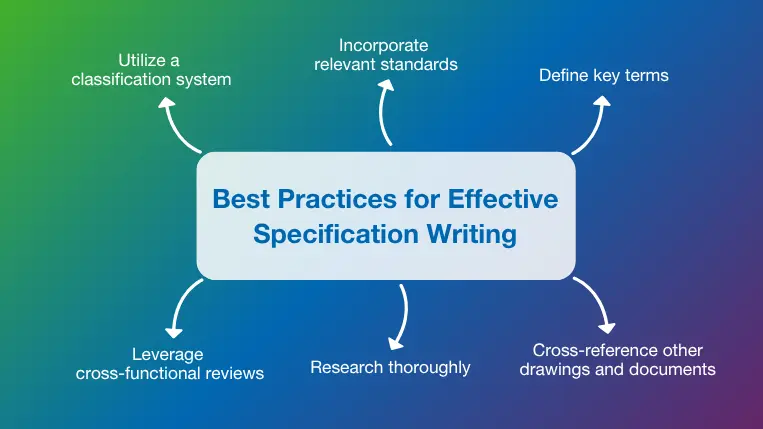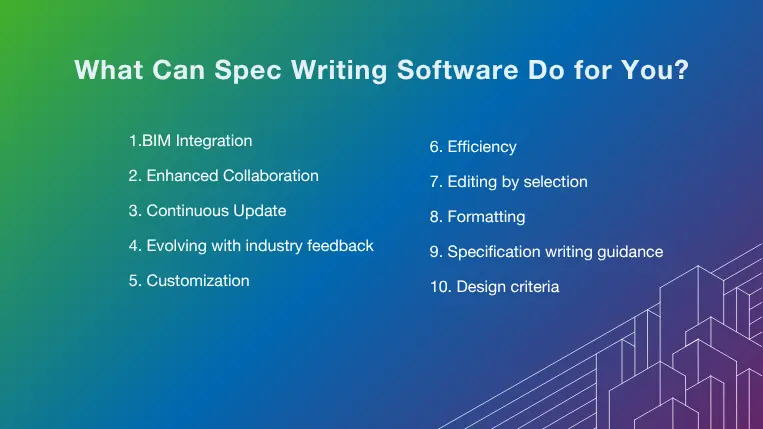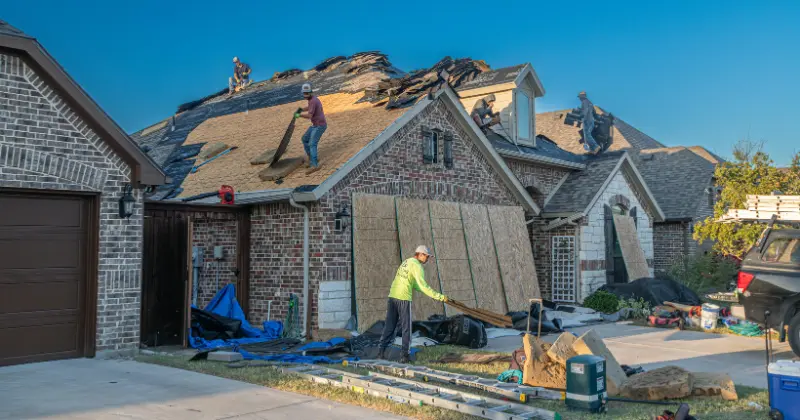10 mins read
Tips And Best Practices For Successful Construction Specification Writing

- What Is Spec Writing?
- How has Specification Writing Changed over the Years?
- Common Challenges in Specification Writing and How to Overcome Them
- Top Best Practices for Effective Specification Writing in Construction
- Spec Writing Trends and Innovations
- What Can Spec Writing Software Do for You?
- Conclusion
Construction specifications are a fundamental element of construction projects. They provide invaluable information about the project’s scope, materials, workmanship, and much more to keep all stakeholders on the same page about how the work is supposed to be carried out.
Considering how important and challenging construction communication has become, having a detailed foundation from which everyone can reference the materials, methods, and standards to follow is an invaluable asset. It prevents misunderstandings and mistakes that can lead to costly rework and delays, and it aids in planning to ensure the project is completed on time, on budget, and in compliance with building and safety regulations.
That said, specification writing (spec writing) is not an easy task. It requires tremendous detail and communication skills to ensure the information is conveyed in an understandable and organized manner.
To help you succeed in the task, we’ve put together this guide that outlines common challenges of specification writing and tips on how to tackle them with the help of professional construction specification tools. Let’s dive in!
What Is Spec Writing?
Spec writing is the process of generating technical specifications for a construction project. Specs include information about materials, performance, testing, warranty, and more to ensure the project’s result meets quality and regulatory requirements.
Traditionally, spec writing was done manually, gathering documentation and information from the different teams through various methods. Today, the process is much faster and more accurate thanks to digital construction technologies like BIM, which provides a 3D model of the project design with valuable data to support various processes, including specifications, estimating, scheduling, and more.
How has Specification Writing Changed over the Years?
Specification writing in construction is almost as old as civilization itself. Structures like the Great Pyramid of Giza, the Roman Colosseum, and the Great Wall of China still baffle modern engineers with their complexity and uncanny durability. These ancient wonders would not have been possible without written specifications describing the size, shape, and type of materials used for each structural element, along with the installation methods required to put the pieces together in the right order.
Verbal instructions certainly played a part in the earliest construction successes, but conveying important design and construction information, both on and off the job site, has always called for skilled construction spec writing. The evolution of this process was a slow and methodical one for hundreds of years, as architectural specifications grew more complex and detailed, but were still meticulously hand-written and hand-copied. The invention of the typewriter and construction blueprints finally began to streamline the process by the late 1800s.
The content of early construction specifications reflects the available technology of the times, and the lack of industry standardization, sustainable building practices, or enforceable safety requirements led to specifications focused on the methods and materials used, with less emphasis on the final outcome. Cumbersome change control and editing processes also led designers and architects to simplify specifications while leaving finer details like installation methods and quality requirements open to interpretation by builders and procurement teams.
Just as computer-aided design (CAD) has revolutionized the construction drawing process over the past three decades, digital specification writing has made it much faster and easier to create, edit, and distribute specifications, with printed paper copies gradually fading into the background as cloud computing and mobile technology bring specifications directly to the contractors and specialists who need them. Technology has also made it possible to improve construction specification writing in many important ways while eliminating previous compromises between safety, quality, and efficiency.
Common Challenges in Specification Writing and How to Overcome Them
Like many other construction processes, spec writing can face challenges that make the document less efficient than it should be. Being aware of these challenges and how to overcome them is a great way to ensure the process is successful from the start!
Ambiguity and wordiness
Ambiguity and wordiness are some of the biggest challenges of spec writing, as using ambiguous and wordy language can lead to misinterpretation of the information and costly mistakes in the project. There are many reasons why professional spec writers can decide to use ambiguous and lengthy writing, like wanting to avoid litigation with contractors or because the project owner wants to ensure every detail is specified to ensure they have control over the outcome.
The truth is the secret to specification success is being clear and concise. It is not about telling the contractor how to do their job with a complex and lengthy sentence; it is about telling them the expectations for the final product. Most products already come with installation instructions and checklists that you can include in the specs. Therefore, it is unnecessary to waste time writing in detail about these things. Focus on using simple language that is straightforward and not confusing. In this case, less is definitely more.
Updating specs
This challenge is connected to the previous one as it is a direct consequence of lengthy writing. During the construction stage, the contractor can suggest changing a specific product because they believe it is the best option or the initial product is unavailable. When this happens, the contractor submits a substitution, the owner approves it, and the change is referenced in the specifications document to avoid any issues later on.
When you take too much time and effort to describe a product in great detail, it will take you more time to adapt the specs in the future. Again, keeping it clear and concise should be a top priority.
Balancing detail and flexibility
As mentioned, project owners often want to keep specifications as detailed as possible to ensure there is no room for error. However, in some cases, that might hinder contractors from using their expertise and experience to improve the project. Therefore, balancing detail and flexibility becomes a challenge.
Detailed specifications help provide clear guidelines about the materials, quality, and processes to follow, significantly reducing the risk of misunderstandings or mistakes. Setting expectations from the beginning also helps maintain a healthy relationship between contractors and the owner.
Allowing for a little bit of flexibility allows the contractor to bring innovation into the project, making it less time-consuming and more cost-efficient. Plus, it gives contractors room to adapt to unforeseen situations without waiting days or weeks for approval. However, too much flexibility can lead to ambiguity and a loss of control over the outcome. Therefore, we suggest finding the perfect balance between detail and flexibility. For example, performance-based specifications detail the desired outcome, leaving contractors free to choose the materials and processes that work best to get there. Ultimately, it is all about choosing the strategy that best fits the project’s needs.
Keeping up with new technologies and regulations
As construction technology, methods, materials, and standards evolve, it is difficult for professionals to stay current and incorporate the latest advancements into their work, especially in complex projects where specific solutions or technical requirements are needed. Luckily, this challenge is easily solved by supporting yourself with the right tools. Professional construction specification writing software is constantly updated to stay current with the latest regulations and codes, ensuring your specifications are, too.
Lack of collaboration
Collaboration in construction projects has always been an important issue. This challenge is also present when writing specifications, as the process requires the input and expertise of various stakeholders. For example, architects and designers focus on the building’s aesthetics and functional requirements; engineers care about structural integrity, technical feasibility, etc.
Gathering input from all stakeholders can become challenging due to misaligned schedules, geographical separation, or many other reasons. Even when digital tools are used, there is the issue of maintaining numerous versions of the same document, making it difficult to keep track of revisions.
Fortunately, collaboration does not have to be a challenge anymore, as specialized construction software offers advanced collaboration capabilities to ensure specs are written in a digital environment that is accessible to anyone, regardless of location or device. These platforms allow users to collaborate simultaneously on specs, leaving a record of any changes or comments to ensure nothing gets lost and the final input is fully accurate and up to date.
Double-checking the work
This is more of a common mistake than a challenge, but it is worth addressing as a key best practice for success.
After you’ve done all the work to put together specs, it can be time-consuming to double-check everything and ensure no mistakes, inconsistencies, or duplicate content is found. Still, it is of the utmost importance to do it. Your specs document should provide all the technical information necessary to complete the project. Therefore, a thorough check of everything is fundamental.
Once you’ve double-checked everything for yourself, you should send it to other project stakeholders and ask for feedback to ensure everyone understands what is written in the document. Remember, collaboration should be at the forefront of the process.
Professional specification writer software can also help you check the content and quality of specs easily and efficiently.
Top Best Practices for Effective Specification Writing in Construction

Overcoming the challenges of construction specification writing is made easier using specialized software tools, but there are many other ways to improve the accuracy and usefulness of specifications, simply by adhering to some industry best practices that have evolved over the years.
Utilize a classification system
Standardized classification systems provide a common language for construction specification writing, as well as all stakeholders who utilize and contribute to the specs. As modern construction projects grow in size and complexity, classification systems make it easier to communicate, release, and store information in a consistent way, while also supporting review and change control processes designed to keep specs compliant and current.
CSI MasterFormat is one such system that has gained a high level of adoption in North America, using a hierarchical system with 50 divisions to divide and organize the various facets of construction work. The system has obvious benefits for construction specifiers, but engineers, architects, estimators, and contractors also benefit from a system that makes it easier to organize and access specifications.
Incorporate relevant standards
Specifications establish design and quality benchmarks for products, materials, and workmanship in construction, which makes it essential to consider all relevant standards and incorporate the information required to stay compliant. For example, the International Building Code (IBC) specifies requirements for fire safety, water egress, and durability that must be carefully reviewed during the specification writing process.
Depending on the project type, scope, and location, many other standards for material quality, reusability, and workmanship are applicable. Including this information reduces ambiguity during the material procurement and building processes, while drawing lines of accountability for standard compliance.
Define key terms
Construction and architectural specification writing require a delicate balance between technical jargon for expert audiences and plain language for stakeholders and workers with limited technical backgrounds. Good spec writers attain the industry knowledge and experience needed to understand complex concepts and terms, but they should also consider their wider audience by including definitions for key terms used to describe material composition, performance standards, or installation methods. These definitions help to remove ambiguity and confusion while allowing construction teams to learn new concepts and apply them to future projects.
Cross-reference other drawings and documents
Construction drawings and specifications are like two sides of the same coin, providing information in different formats that complement and enhance the information found in related documents. Drawings rely on visual images and dimensions, but specifications convey information primarily through words. For example, a ceiling plan showing the exact position of fixtures, panels, and drops might refer to multiple specifications to provide complete information on each element.
Specs might also point back to drawings to explain how individual pieces fit into the overall design. These links require careful editing and review to ensure drawings and specifications do not conflict with one another.
Research thoroughly
Specification writing software and other advanced tools continue to take the legwork and guesswork out of specification writing, but overreliance on technology can be a dangerous mistake. Submittal requirements, special warranties, field testing instructions, and quality sampling plans are just some of the elements contributing to the intricate web of information.
Software tools can make it easier to leverage past projects, find relevant information, and transfer high-level requirements into specifications quickly, but thorough research is still required to ensure specifications are up to date and compliant, and align closely with design intent. This additional research and attention to detail helps to minimize confusion and delays as specifications make their way from the office to the jobsite.
Leverage cross-functional reviews
It is important to understand that spec writing should never be a one-person job, no matter how skilled or experienced the writer is. In addition to the error and formatting corrections that come from an adequate review cycle, cross-functional teams improve specification quality by providing input from multiple perspectives. Architects and subject matter experts might notice areas requiring additional information or clarification, while other stakeholders might detect conflicts with previously published specifications, drawings, or documents. Cross-functional feedback ensures these issues are corrected easily and future spec changes are minimized.
Spec Writing Trends and Innovations
The long history of construction spec writing has been marked by numerous advancements and inventions that have increased the quality, speed, and accuracy needed to complete today’s most ambitious projects. The latest industry trends and innovations are poised to take these practices to the next level.
BIM
Building information modeling (BIM) is quickly redefining all aspects of the construction industry by moving building design, testing, and project management processes into the digital realm, and creating a unified, collaborative workspace. These capabilities also enhance the specification writing process, with the common platform making it easier to synchronize specifications and design elements in real-time, and automatically identifying conflicts between architectural concepts and physical specifications.
Although BIM will not take the place of written specifications, the detailed information included in multi-dimensional models accelerates and enhances spec writing and change management processes.
Sustainable building standards
Builders and architects striving to meet the sustainability targets of rating systems like LEED and BREEAM can only be successful when the requirements for eco-friendly systems, products, and materials are woven into the construction specification writing process. This includes lifecycle data to quantify overall environmental impact, material reuse information, and carbon benchmarks that ensure the overall carbon footprint of a structure is within expected limits. Advanced spec writing software allows project teams to effortlessly cascade high-level sustainability goals into each relevant specification.
AI and automation
So far, we have only scratched the surface of what generative artificial intelligence (AI) and automation can do to improve spec writing. The human element will always be essential, but AI tools can analyze any combination of material, compliance, and project constraints to recommend changes or create all new specifications based on predefined templates.
As AI and automation are integrated into the spec writing process, predictive analytics will help spec writers improve their accuracy and identify appropriate materials and methods that can help the project team save money. With AI tools to create baseline specifications, optimize decisions, and review compliance issues, specification writing experts will have more time to innovate and collaborate.
Cloud-based collaboration
The shift to cloud computing has been a useful development for specification writing, making it easier for multiple stakeholders to work on the same documents simultaneously, no matter where they are located. Real-time comments and change tracking throughout writing and review cycles help to minimize errors and post-release changes. Cloud-based collaboration also allows project teams to seamlessly link their work to design, regulatory, sustainability, and quality databases to simplify the propagation of essential project information into the specs, and ensure the latest technical resources are always available.
What Can Spec Writing Software Do for You?

In the past, processes like estimating or spec writing were tedious and time-consuming. Luckily, this is not the case today, as construction software solutions have been developed to make these processes more automated, efficient, and accurate in significantly less time. However, many companies in the building sector are reluctant to adopt new technologies because the traditional way of doing things still works for them. The industry is now moving at a fast pace, and companies that don’t invest in modernizing their processes will simply stay behind.
Spec writing software is one solution that has revolutionized the market due to its ability to enhance the specification process and add value to the entire project. Our spec writing software, RIB SpecLink, is a cloud-based platform that centralizes all project data and provides a single source of truth for quality specifications. Below, we discuss what our software can do for you!
1. BIM Integration
SpecLink’s common SQL data environment is compatible with the Revit platform. Our BIM integration tools provide visualization to help prevent breakdowns in design intent between stakeholders. Our approach is flexible; we don’t force a particular workflow or absolute relationship between BIM elements and specifications. It’s also all in the cloud for ease and flexibility.
2. Enhanced Collaboration
We provide collaboration tools within a common data environment to connect stakeholders and track changes as your projects advance. The cloud makes it easy to share and review specifications with design partners, owners, consultants, and contractors. You can access projects on any browser-enabled device and set restrictions to control who has access to the information.
3. Continuous Update
RIB’s continuous updates are unmatched in the industry. Our in-house content team makes daily updates to keep standards and code references current and improve content.
4. Software evolving with industry feedback
RIB has the most innovative and technologically advanced software on the market, with continuously updated content. We know how important it is to learn from our subscribers and are committed to developing new solutions to industry needs through frequent content and product updates. Our new Specification Content and User Experience Advisory Committee, made up of experts from leading firms, reflects our deep commitment to ensuring the needs of our users are met.
5. Customization
Our import-friendly technology enables you to bring your favorite content into SpecLink, where you can take advantage of the RIB suite of tools. Embrace new possibilities with automation and intelligent tools that can make your content easy to maintain and update.
6. Efficiency
Our intelligent linking and deductive reasoning are integrated into the SpecLink user experience. We provide direct access to reference standards and building product manufacturers that we cite within the application. Intelligent linking, normalized reference standards, and global terms allow you to eliminate repetitive administrative edits so you can focus on more important tasks.
7. Editing by selection
When you edit in SpecLink, the master text is never deleted; you simply turn it on or off, and only the text that is “on” is assembled into the project specifications. Master text that you don’t include is always available for reference or inclusion later — and to prompt additional decisions when something changes or other alternatives need to be considered.
8. Formatting
With SpecLink, you can collapse the master project to produce pre-edited outline specifications, expand it partially to produce short-form specs, and expand it fully for construction documents. You can edit as needed at any phase to adapt the master specifications to your specific project.
9. Specification writing guidance
Our series of supporting documents and master notes provide deep knowledge and insight into how we created a section, including what we researched, and offer guidance on how to specify the work results in a section.
10. Design criteria
One of our strongest attributes is the ability to use SpecLink across all the phases of construction. Our design criteria catalog enables you to lay out requirements in a preliminary project description/Uniformat structure to connect cost estimating with design and performance requirements.
Conclusion
As you learned throughout this post, the specification writing process requires thoughtful planning, communication, and collaboration to succeed. With the support of the right tools, specifiers are armed with innovative functionalities that make the final product more accurate and efficient in significantly less time.
RIB SpecLink is not only a leading specification software tool but also a team of skilled specification writers who work behind the scenes to ensure standards, building codes, and design guides are kept up to date in accordance with national construction specifications, safety regulations, and LEED specifications.
RIB SpecLink helps spec writers improve and optimize the specification writing process by offering a single source of truth for all project data and documents. Our people are a lot like you. We are experienced architects, engineers, and specification writers developing solutions for modern professionals and companies in the building sector. If you are ready to benefit from innovative construction specification software, get a demo for RIB SpecLink today!

Most Recent
10 mins read
10 mins read
11 mins read
10 mins read
Blog Categories

Ebook











